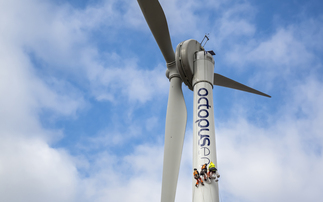Dr Rob Wylie of WHEB Partners reveals his top tips for attracting green investors
As many low-carbon businesses find themselves caught between a dearth of bank finance and a reticence among direct investors to fund as-yet unproven technologies, Dr Rob Wylie, partner at leading European cleantech fund WHEB Partners, offers some advice
Low-carbon investment cuts across almost all industrial sectors and technologies. It involves investment in more efficient and sustainable ways for addressing the huge challenge of a rapidly growing population's demands for energy, food and water. These resources are all interconnected and any appropriate solutions would almost always involve the use of less energy and hence can be viewed as 'low-carbon'.
Some examples to illustrate this: Exosect from the UK has developed a way for controlling insect pests with natural alternatives to pesticides. Trucost has calculated that 40,000 tonnes of CO2 will be saved for every two million hectares of rice treated with Exosect product rather than conventional chemical pesticides. Some 70 per cent of all water is used in irrigation of agricultural crops. This requires the pumping of water and hence energy use. US-based AquaSpy has shown over many years that through a combination of sensors, telemetry systems and software irrigation can be done more "intelligently" leading to vast savings in water and hence energy used as well as increased yields. Hence low-carbon investment is not just about renewable energy production and energy efficiency.
Investment Trends
Investment levels have grown tenfold between 2003 and 2008 to a figure of around $840bn. There was a sharp downturn in 2009 as there was in all areas. However, the commonly held view is that this is the one area capable of sustainable growth going forward, albeit with periodic adjustments, and presents huge opportunities for innovation. It's rare for Presidents and Prime Ministers to lobby on behalf of a sector and perhaps even rarer to promise to put money into it but that is what is happening with low-carbon.
Investment levels during 2010, on the face of it, appear to have returned to those seen in 2008. However there are some stark changes. Firstly, the North American market in terms of VC investment now accounts for some 75 per cent, and California around 50 per cent, of the global total, with Europe's percentage share reducing. Secondly, these investments have been dominated by large follow on rounds of existing and largely solar deals with investments in early stage deals being the same as during the height of the financial crisis in 2009. Thirdly, while North America and Europe remain dominant in VC funding, the IPO market, still well below 2007 levels, has seen a huge increase in activity in China. Up until the financial crisis Europe was the major market for IPOs. During the last quarter they only represented around two per cent of the total by value with China representing over 70 per cent.
Opportunities abound or not?
Given the scale and breadth of opportunities and the level of government support surely it must be a nirvana for innovators, investors and corporates. Unfortunately not. Like all other sectors the low-carbon economy is just as susceptible to the economic crunch and, and in some cases, more so. A few pertinent facts:
Changes in investment appetite - It is still a fairly new area for investment. There isn't sufficient track record of cash for cash returns to help low-carbon VCs raise new funds. This has not been helped by the IPO markets being very nervous of new offerings, except for companies showing sustainable profit growth, and the M&A market being very cautious over the past 18 months. The credit crunch has also meant that traditional investors in VC funds, such as pension funds, are either not investing in VC or only doing so in VCs with whom they already have long standing relationships - not good news for the newer specialist low-carbon funds. On the other hand there are now many low cost opportunities for less risky late stage or growth deals due to a combination of market reality and the dearth of bank finance. This combination of factors has led to a focus by most VCs for supporting their existing portfolios and on late stage investments. There is therefore a real danger that promising early stage low-carbon companies will fail to raise finance and fall by the wayside.
Even in the good times it should be recognised that most VCs tend to invest in only 0.5 per cent to one per cent of all the investment proposals they see - there is a very high attrition rate.
Changes in Corporate attitudes - Corporates have increasingly made public their interest in this area and many have developed VC activities of their own, co-investing alongside traditional VCs. The reality is that, as in other areas such as biotech, they now prefer to have a fully proven product to exploit, avoiding technical risk even if it is "low C". An additional characteristic of corporates in this area is that they are often utilities, and traditionally risk averse.
Changes in Exit Possibilities - As stated above the IPO markets are essentially shut to anything but companies with profitable track records and/or good prospects for growth - it has proven very risky to float to finance negative cash flow with many companies pulling their flotation plans. There are some high profile exceptions such as Tesla but these are rare. The credit crunch has forced companies to be more conservative about how to finance and value acquisitions. This might change but the M&A exit route in 2009 for innovative small companies was dire and perhaps will only marginally improve in 2010.
How to succeed
Innovative companies need money and that is now much harder to get. The quick answer is that innovators and investors have to be more innovative and take a reality check on the market. There are still huge opportunities to be had. Some thoughts which might help:
1. Be realistic about cash requirements - these are almost always two to three times higher than expected requiring multiple investment rounds. Given the current difficulties in raising VC funds and not being able to rely on IPOs for later rounds, VCs are very wary of being caught out without any money to invest just when the business is taking off. This is when the new investors can take advantage of those not being able to "pay and play". As a general rule all VC funds cannot invest more than 10 per cent of their total fund size in any one investment.
2. Find ways to generate profitable revenue early - it might not be in your largest market opportunity but the learning curve on the applicability of your product will have been done. UK based Bowman Power has developed turbo-generation technology for large diesel engines which uses the 35 per cent of energy lost through the exhaust to generate electrical power which can then be fed back to the engine or used to drive auxiliary systems. The big opportunity is in mobile applications but this requires incorporation in the engine design and long term testing by the large truck manufacturers. A quicker market entry lies in retrofitting static diesel gensets where Bowman can show up to 10 per cent fuel savings. Bowman has won large orders for this area in Europe and Australia and, through this has the platform to become profitable, refine its technology and iron out teething problems in large scale manufacturing.
3. Look carefully at sales lead times - these always tend to be underestimated with corporate partners and municipalities seeming to live in another time zone when it comes to making decisions. In the current economic environment we can see even further delays in making investment decisions and time costs money which goes back to the point about cash requirements.
4. Avoid capital intensive projects - unless it is clear how they can be financed either through corporate or government guaranteed support and be careful on reliance on government subsidies for economic viability. Assume Governments will change their minds in the current environment - they will. Fantastic progress has been made in a wide variety of renewable energy technologies. In certain areas, such as onshore wind, it is reaching the goal of grid parity in pricing. Solar is becoming highly competitive with low-cost Chinese suppliers posing a growing threat to Western suppliers. However, there is evidence that Government subsidies in many countries are now being reduced leading to investment uncertainly. During the times when banks actually lent money and credit was cheap the capital intensive nature of this area did not seem to be a deterrent to some of the enthusiasts. It is now a huge problem for new developments and will hinder the further development of the less proven technologies such as wave and tidal.
5. Find an investor syndicate which will add value and has business experience - they all say they do but unfortunately that is sometimes not the case - inexperienced investors can seriously wreck a business. Whenever we undertake an investment outside the UK and Germany where we have offices we always insist on having a local active investor who is known to us and can add complementary expertise. Sensortran, based in Texas, services the oil, gas and the power transmission industries with technology that can monitor the condition of pipelines and power lines to identify leaks and hot spots and thereby take preventative action virtually in real time. WHEB's co-investors include a Texan oil and gas specialist as well as other US based funds. WHEB's role in the syndicate is to help with European expansion. Netherlands based fluXXion, a spin out of Philips, uses microelectronics technology for process intensification within the chemical and food industries. The investor syndicate comprises Dutch speakers (very important for legal documents!) and people having appropriate technical expertise and contacts within the relevant target sectors.
6. Be realistic about your skills to do the plan - hire people who are more experienced and cleverer than you are - easy to find but difficult to do - it's called strengthening the team and succession planning! Investors can take two extreme approaches to this. On the one hand there are those that raise this at the last minute as a "fait accompli" - not conducive to an ongoing working relationship - and there are others that raise succession planning at a very early stage of due diligence and often incorporate an independent review of the management team as part of the due diligence process. If we cannot come to agreement on this with management during due diligence we do not invest and this is quite typical of most investors. This is a crucial part of any investment as the skills required by top management change with the development of the business.
7. On a similar vein hire a useful board of independent non-execs - who can genuinely open doors, are willing to do so and are strong enough to make investor directors listen. Again this can change with the development of the business but these individuals are chosen for their senior level contacts in target markets and for expertise in exits. Dealing with large customers and distribution partners often entails a "pincer" movement with the company working at the operational level and the non-exec promoting the company at senior level thereby, hopefully, shortening the decision making process.
8. Be careful of markets requiring government certification or approval - these can be very expensive in terms of delayed sales and something that EU governments in particular seem to be reluctant to address. One example of this would be in the construction industry for products designed for energy efficient buildings. This often involves new materials which are not covered by the standard certification procedures required by the sector.
9. Big is not always beautiful when it comes to distribution partners - and avoid leaping into exclusive arrangements. Large corporates tend not to be good at creating new markets but are good at exploiting these markets when traction is demonstrated. Hence small hungry partners can often produce better results at an early stage. Exclusive arrangements can hinder an exit, much better to slice and dice the market with a range of partners, many of whom could be exit options, and hence create a "competitive tension" amongst them. Nothing like creating the framework for an exit auction at an early stage!
10. Finally be realistic about valuation - Having 10 per cent of something that is worth something is better than having 100 per cent of something that is worth nothing. VC investors evaluate an investment on the basis of being able to show how a 5-10x return can be made within three to five years. They will have views based on market research on what exit values could be possible within this time frame and entry valuation is then derived from this. This is part art, part science but the reduction in M&A and IPO activity coupled with scarcity of funds has led to downward pressure on entry valuations and this is likely to continue. This means that 2009/2010 could be vintage years for those VC funds that have money to invest.
Conclusion
The low-carbon investment area is starting to mature with definite and continuing market drivers and an increasing number of experienced investors and entrepreneurs. It is one of the most exciting and sustainable areas of investment but, as with all others, not without its difficulties, none of which are insurmountable.
The data in this article is collated from New Energy Finance and Cleantech Venture Network and WHEB's own database.
Dr Rob Wylie focused on the clean technology investment area at Shell and KPMG before becoming a founder partner of WHEB Partners, which raised the UK's first broad-based clean tech VC fund in 2005. WHEB now manages two specialist clean tech private-equity funds, which invest in low-carbon companies with high growth potential, with total assets under management of £130 million. Rob is also a co-founder of WHEB's associated companies WHEB Asset Management, a fund management company that focuses on investing in listed sustainable stocks; and WHEB Infrastructure Partners, a fund for investing in renewable energy projects. Contact Rob Wylie on [email protected].
This article first appeared in the ENDS Carbon Yearbook







